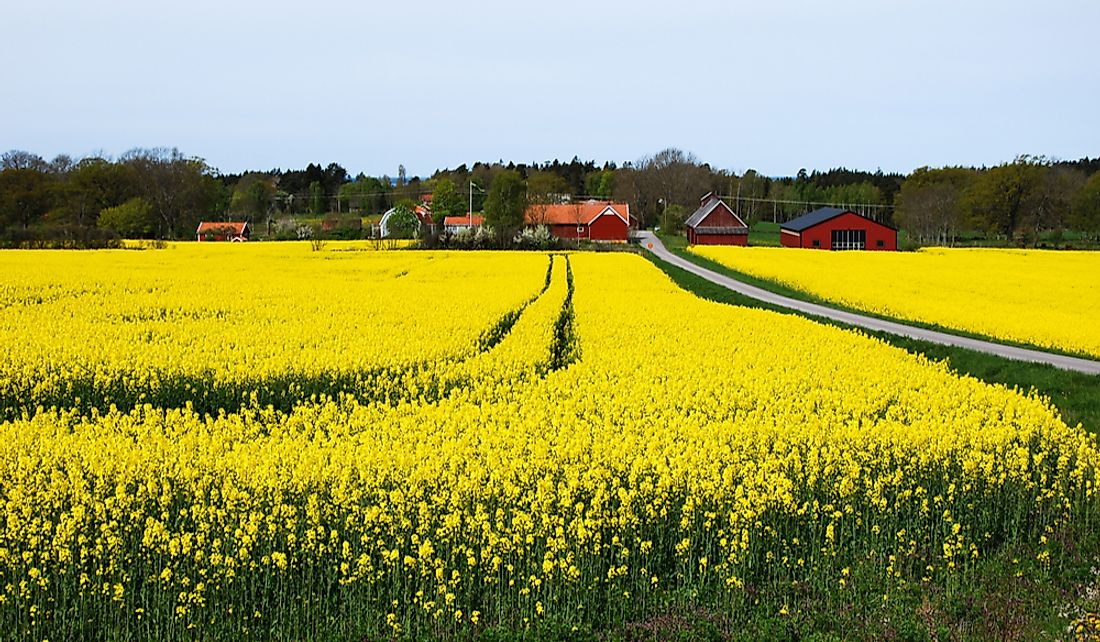What Are The Biggest Industries In Sweden?

Sweden is one of the Scandinavian countries which is found in the northern part of Europe. The country covers an area of 17,380 square miles, making it northern Europe’s largest nation and the third largest in the EU. The country has a population of 10.2 million inhabitants according to the census of 2018. According to GDP per capita, Sweden is one of the richest countries in Europe. Sweden has a developed export-oriented economy that is heavily dependent on manufacturing. Other industries include agriculture, tourism, and finance.
Agriculture
In 1999, only 2% of the country's workforce derived their livelihood from agriculture and this contrasted with the figures at the beginning of the 20th century when about 50% of the country's workforce was engaged in agriculture. In the 1950s, about 20% of Sweden’s labor force was engaged in agriculture. Blessed with significant natural resources, agricultural output in Sweden exceeds domestic consumption, although the country imports a significant amount of food items. Approximately 6.8% of the country's total land area which is equivalent to 6,894,100 acres of land is arable, and they are under temporary or permanent crops. As of 2000, there were approximately 76,798 landholdings with more than five acres of arable farms. Farms in the country are typically tilled intensively, and heavy use of fertilizers is widespread, which are highly mechanized. Between the 1980s and 1990s agriculture expanded at an average rate of 1.5% annually but during the 1990s and 2000 it remained relatively unchanged. The majority of farmers in the country are the elderly, and most farms do not have successors to continue farming in the country has become a major concern for the government. In the recent past, the government has introduced a policy to try and merge small farms into large units of approximately 25 to 50 acres of land. The majority of farmers in Sweden are small scale who support the fishing and forest, and as of 2000, about 54% of the farms were below 50 acres. Some of the crops cultivated in the country include potatoes, barley, wheat, rye, vegetables, and fruits.
Manufacturing
Sweden has an efficient export-oriented manufacturing industry which contributes significantly to the country's economy. There are few employees in the private manufacturing industries compared to employees in the public manufacturing industries. Privately owned companies in the country account for about nine-tenths of the industrial output. Automotive is the largest sector of the manufacturing industry which accounts for almost half of the industrial value-added. The aerospace and automotive manufacturing plants are located in the southern part of the country, and automakers such as Saab and Volvo are recognized globally. The electronics and electric plants are located mainly in Västerås and Stockholm. The city of Stockholm is the largest producer of communication equipment in the country while small plastic and metal processing plants are found in the southern part of the country. Stenungsund, which is located on the Western coast of the country, is famous for the petrochemical industry. Biotechnology and pharmaceuticals are some of the fastest-growing sub-sector in the country, and they are located near the top leading medical research centers in the country.
Tourism Industry
Tourism in Sweden accounts for a relatively small portion of the country's economy, and in 2011 they contributed 2.9% of the GDP and earned the country approximately 264 million Swedish kroner and out of this about 928 billion was a result of expenditures from foreign visitors. In Sweden, 7.1% of household income is spent on local tourism. Most of the tourists who visit Sweden are primarily from neighboring countries such as Norway, Denmark, and Finland. Other countries with a significant source of tourists to the country include the United Kingdom and Germany. Some of the attractions in the country including the Vasa Museum and Drottningholm Palace Theatre. Other attractions include literature, Swedish art, music, and modernism. The country has 13 UNESCO World Heritage sites. The majority of tourists visit the country, particularly in the summer when temperatures are relatively high, are destined to Skåne and the central and southern coast of the country which have beautiful sandy beaches. Gotland is another famous region for visitors, particularly during the summer period. In 2006, the country received 7.6 million visitors and by 2016, the country was receiving about 13.9 million visitors.
Trade and Finance
Exports from the country contribute about one-third of the GDP, and currently, the country export finished goods which are dominated by engineering products such the telecommunication equipment, cars, and hydroelectric power plant equipment. The country also exports chemical and biotechnology and high technology equipment. Most of these products exported mainly to the United Kingdom Germany, Denmark, Finland, and Norway which account for about two-thirds of the country's export market. The country's imports are generally diversified compared to exports. Initially, petroleum was the single most critical import, particularly before the 1980s when it accounted for almost 1/4th of the total value. The country imports most of its products from Norway, Netherlands, Denmark, and the UK.
Projection of the Swedish Economy
The economy of Sweden is regarded as a mixed economy which is characterized by the welfare state and is largely financed through the country’s high-income taxes that ensure revenues are spread across the whole society. The economic model in the country is often known as the Nordic model. The national wealth owned by the government in 2014 was about 24.1%. According to European Commission GDP growth for Sweden in 2017 was 2.1%, in 2018 the growth rate was 2.3%, 2019 the growth rate is projected at 1.4%, and in 2020, it is projected to grow at a rate of 1.6%.











